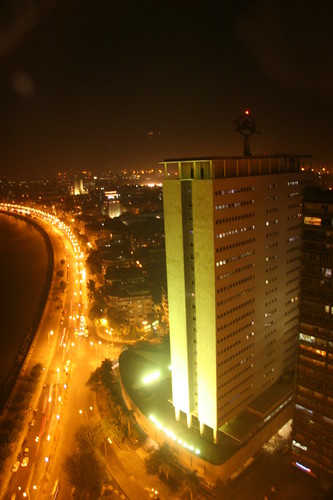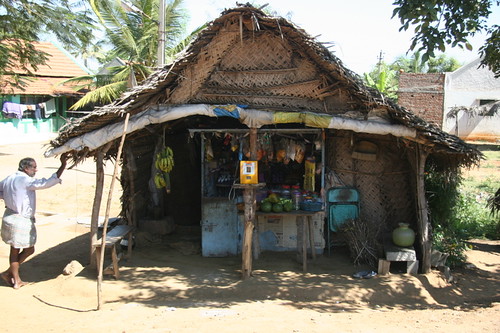In part one I briefly mentioned the Jawaharlal Nehru Port Trust, the enormous complex of container terminals that handle over 60% of all sea freight that comes in and goes out of India. At the moment JNPT serves 25 ICDs (inland container depots) with plans for another 9 over the next few years. The port sees textiles, foodstuffs and medicines exported worldwide while at the same time chemicals, oils, petrol, plastics and heavy machinery are imported to aid the phenomenal growth in the Indian manufacturing economy.
JNPT is made up of 3 terminals: Gateway Terminals India is a container port with the capacity to process 1.3m TEUs a year, there is also a liquid cargo jetty capable of handling 5.5 million tonnes annually (including industrial and edible cargo such as molasses and vegetable oil), and finally the Nhava Sheva International Container Terminal, India's first private port.

Vessel loading at Nhava Sheva (NSICT)
We were fortunate enough to have an extensive tour of the facilities at Nhava Sheva, facilities that rival those anywhere else in the world (and I've seen a lot of container ports in my time...!). With the capacity for 100 moves per hour I was impressed by the efficiency of the operation, I was even more impressed when the CEO, Capt Rustom Dastoor, mentioned that they are on target to move 1,400,000 TEUs by the end of the year.
For those of you who don't speak logistics jargon, a TEU is a 'twenty-foot equivalent unit' - a container that is about 20ft by about 8ft. At the moment the TEU is the standard size of container, there are a smaller number of 10ft containers in use, and an increasing number of 40ft containers, these are sometimes referred to as 2 TEUs or logically FEUs. If all of the containers that NSICT moved in 2007 were laid side by side and end to end they would cover over 8 sq miles of land. To put it another way, if you were stood in the centre of this sea of containers, you wouldn't be able to see the edge. By 2015 JNPT as a whole is expecting to be handing 8m TEUs a year - That's 43 sq miles of containers. If you were driving at 30mph it would take you over 5 and a half hours just to drive round the perimeter.
To prepare for this, as well as the work I mentioned on the roads supplying the port, hundreds of crores (in India 1 crore = 10 million) of Rupees are being spent on expanding the container berth, improving the rail network to the ICDs and digging out the harbour channel so that it is deeper and wider to accommodate the ever expanding size of the ships that carry the containers all over the world. They are also planning a 4th terminal that will be bigger than the rest of JNPT put together.

Aerial view of NSCIT Terminal and Gateway To India Terminal
But the Nhava Sheva terminal isn't just some multinational company moving in and exploiting the natural resources of the area, they also have a real sense of what corporate social responsibility means. Many of the staff are recruited from the surrounding villages and given training above and beyond what is needed to carry out their day to day jobs. In addition to this DP world, the company that manages NSICT has also adopted the local community college with work beginning this summer on a new school building which will include science labs and a library.
Congestion is still a problem at JNPT though. The average container can wait up to 7 days to clear the port complex due to the sheer volume of containers being processed. Cargo throughput surged 26.4% in the 1st seven months of fiscal 2007/8 to 2,700,000 TEU across the three terminals and JNPT and Customs officials are looking at ways to cut down the waiting times while maintaining this phenomenal growth.
It is this sort of dual progress which is propelling India into the forefront of international trade, providing not only world class facilities but a world class workforce to run them to a world class standard.
If you have any queries on freight to and from India, please do not hesitate to contact one of our team on +44(0)121 713 7250 or by email for advice or further information.










